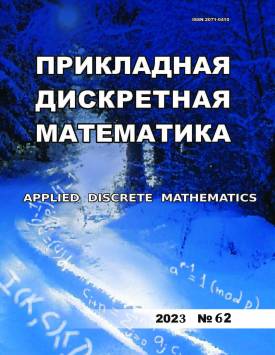Известно, что любой поточный шифр основан на хорошем генераторе псевдослучайных чисел. В криптографических целях изучаются различные способы генерации псевдослучайных последователвностей с максимально возможным периодом. Регистр сдвига с обратной связью - один из криптографических примитивов, который используется для построения поточных шифров. В работе изучаются периодические свойства псевдослучайных последователвностей, создаваемых фильтрующим и комбинирующим генераторами (известными схемами поточных генераторов на основе регистров сдвига с обратной связвю). В этих схемах анализируются функции, которые приводят к выходным последователвностям с периодом не менее заданного числа l. Мы называем такие функции l-подходящими и подсчитываем их точное количество для произвольного n.
Скачать электронную версию публикации
Загружен, раз: 8
- Title On the number of ℓ-suitable Boolean functions in constructions of filter and combining models of stream ciphers
- Headline On the number of ℓ-suitable Boolean functions in constructions of filter and combining models of stream ciphers
- Publesher
Tomsk State University
- Issue Прикладная дискретная математика 62
- Date:
- DOI 10.17223/20710410/62/3
Ключевые слова
булева функция, комбинирующий генератор, фильтрующий генератор, поточный шифрАвторы
Ссылки
Carlet C. Boolean functions for cryptography and error-correcting codes. Y. Crania and P. L. Hammer (eds.). Boolean Models and Methods in Mathematics, Computer Science, and Engineering, Cambridge, Cambridge University Press, 2010, pp. 257-397.
Golomb S. W. Shift Register Sequences. San Francisco, Holden-Dav, 1967.
Gluhov M. M., Elizarov V.P., and Nechaev A. A. Algebra (Algebra]. Moscow, Gelios ARV Publ., 2003. 336 p. (in Russian).
Hell M., Johansson T., and Meier W. Grain: A stream cipher for constrained environments.Intern. J. Wireless Mobile Computing, 2007, vol. 2, no. 1, pp. 86-93.
Bonich T.A., Panferov M. A., and Tokareva N.N. On the number of unsuitable Boolean functions in constructions of filter and combining models of stream ciphers. Prikladnava Diskretnava Matematika. Prilozhenie, 2020, vol. 13, pp. 78-80.
Gollmann D. Kaskadenschaltungen taktgesteuerter Schieberegister als Pseudozufallszahlengeneratoren. PhD thesis, Johannes Kepler Universitat Linz, Wien, 1986. (in German).
Canteaut A. A5/1. Encyclopedia of Cryptography and Security, Boston, Springer, 2011, pp. 1-2.
Key E.L. An analysis of the structures and complexity of nonlinear binary sequence generators. IEEE Trans. Inform. Theory, 1976, vol. 22, pp. 732-736.
Gorodilova A. A. Ot kriptoanaliza shifra к kriptograficheskomu svovstvu bulevov funktsii [From cryptanalysis to cryptographic property of a Boolean function]. Prikladnava Diskretnava Matematika, 2016, no. 3(33), pp. 16-44. (in Russian).
Mdrton K., Suciu A., Sacarea C., and Cret O. Generation and testing of random numbers for cryptographic applications. Proc. Romanian Academy, 2012, vol. 13, pp. 368-377.
Parvees M.Y.M., Samath J.A., and Bose B.P. Cryptographically secure diffusion sequences - an attempt to prove sequences are random. Advances in Big Data and Cloud Computing. Advances in Intelligent Systems and Computing, 2019, vol. 750, pp. 433-442.
Menezes A. J., Van Oorschot P. C., and Vanstone S. A. Handbook of Applied Cryptography. Boca Raton, CRC Press, 1996. 780 p.
Hamza R. A novel pseudo random sequence generator for image-crvptographic applications. J. Inform. Security Appl., 2017, vol. 35, pp. 119-127.
Goresky M. and Klapper A. Algebraic Shift Register Sequences. Cambridge, Cambridge University Press, 2012. 496 p.
Golic J. D. On the security of nonlinear filter generators. LNCS, 1996, vol. 1039, pp. 173-188.
Courtois N. T. and Meier W. Algebraic attacks on stream ciphers with linear feedback. LNCS, 2003, vol. 2656, pp. 345-359.
Salhab O., Jweihan N., Jodeh M.A., et al. Survey paper: Pseudo random number generators and security tests. J. Theor. Appl. Inform. Technology, 2018, vol. 96, pp. 1951-1970.

On the number of ℓ-suitable Boolean functions in constructions of filter and combining models of stream ciphers | Прикладная дискретная математика. 2023. № 62. DOI: 10.17223/20710410/62/3
Скачать полнотекстовую версию
Загружен, раз: 93